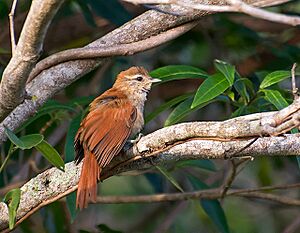Rusty-backed spinetail facts for kids
Quick facts for kids Rusty-backed spinetail |
|
|---|---|
 |
|
| Conservation status | |
| Scientific classification | |
| Genus: |
Cranioleuca
|
| Species: |
vulpina
|
 |
|
| Synonyms | |
|
Cranioleuca dissita Wetmore, 1957 |
|
The rusty-backed spinetail (Cranioleuca vulpina) is a small bird found in South America. It belongs to the ovenbird family, which is known for building unique nests. This bird lives in several countries, including Bolivia, Brazil, Colombia, Paraguay, Peru, and Venezuela. It might also be found in Guyana.
Contents
About the Rusty-backed Spinetail
The rusty-backed spinetail was first officially described in 1856. An Austrian scientist named August von Pelzeln gave it the scientific name Synallaxis vulpina. The word vulpina comes from Latin and means "fox-like." This refers to its reddish-brown color, similar to a fox.
Today, this bird is part of the Cranioleuca group. Scientists recognize four main types, or subspecies, of the rusty-backed spinetail:
- C. v. apurensis
- C. v. vulpina
- C. v. foxi
- C. v. reiseri
Some birds that were once thought to be types of rusty-backed spinetails are now considered their own separate species. These include the Coiba spinetail and Parker's spinetail.
What Does It Look Like?
The rusty-backed spinetail is a small bird, usually about 15 to 16 centimeters (6 inches) long. It weighs between 14 and 17 grams, which is about as much as a few paper clips. Both male and female birds look very similar.
Adult birds have a light brownish face with a pale stripe above their eye. Their forehead is brown, and their back and crown are a reddish-chestnut color. Their tail and wings are also reddish-chestnut. The tips of their flight feathers are a bit darker.
Their chin is a creamy white, and their throat is a light buff color. Their chest is light brown, and their belly is plain light brown. Their eyes are dark reddish-brown. Their beak is dark on top and lighter underneath. Their legs and feet are a dull greenish or grayish color.
Young rusty-backed spinetails look a bit different. Their upper parts are more grayish than adults, and their underparts might have some faint spots.
Each subspecies has slight color differences. For example, C. v. apurensis is the darkest type. C. v. foxi has darker reddish-brown upper parts. C. v. reiseri is generally paler but has more reddish upper parts.
Where Does It Live?
The different types of rusty-backed spinetails live in specific areas:
- C. v. apurensis lives in western Venezuela.
- C. v. vulpina is found in northeastern Colombia, central and southern Venezuela, parts of northern and central Brazil, and eastern Bolivia. It might also be in eastern Paraguay and western Guyana.
- C. v. foxi lives in central Bolivia.
- C. v. reiseri is found in northeastern Brazil.
Scientists have only seen this bird a few times in Guyana, so they are still checking if it truly lives there.
This bird likes to live near water. You can find it in forests along rivers, in thick bushes on river islands, or in swampy forests. It also lives in bushy areas around lakes and streams. It can be found from sea level up to about 400 meters (1,300 feet) high.
Behavior and Life
Movement
The rusty-backed spinetail does not migrate. It stays in the same area all year round.
Feeding Habits
This bird eats arthropods, which are creatures like insects and spiders. It usually looks for food alone or with one other bird. Sometimes, it joins groups of different bird species that are feeding together.
It mostly searches for food in the lower parts of the forest. It is very agile and can pick prey from tree bark and dead leaves. Sometimes, it even picks food from live leaves while moving along small branches.
Reproduction and Life Cycle
Scientists are still learning about the rusty-backed spinetail's breeding season. It seems to happen at different times depending on where the birds live. Eggs have been seen in June and July in Venezuela, and in November in eastern Brazil.
The nest of the rusty-backed spinetail is shaped like a ball. It is made from grass, roots, and small sticks. The inside is lined with shredded bark and moss-like plants called lichens. These nests are often placed in the fork of a low tree or bush, usually above water. They can look like natural debris left by a flood. A female bird usually lays two or three eggs. Not much else is known about how they raise their young.
Vocalization
The rusty-backed spinetail has a unique song. Some people describe it as a fast series of strong notes that get faster but then fade away. It sounds like "ch-ch-ch-chchchchchewewewewewew" and lasts about 2.5 to 3 seconds. Others describe it as a series of complaining notes that go down in pitch, like "scew-scew-scew-". It can also sound like a "rattly trill" that goes down in pitch.
Its call is a soft, nasal sound. It might sound like "choy," "choy-choy," or "kuee-kweek."
Status
The IUCN (International Union for Conservation of Nature) has listed the rusty-backed spinetail as a species of "Least Concern." This means it is not currently in danger of disappearing. It lives across a very large area. However, scientists do not know exactly how many of these birds there are or if their numbers are changing. There are no immediate threats that scientists have found. This bird is considered fairly common in the places where it lives.


